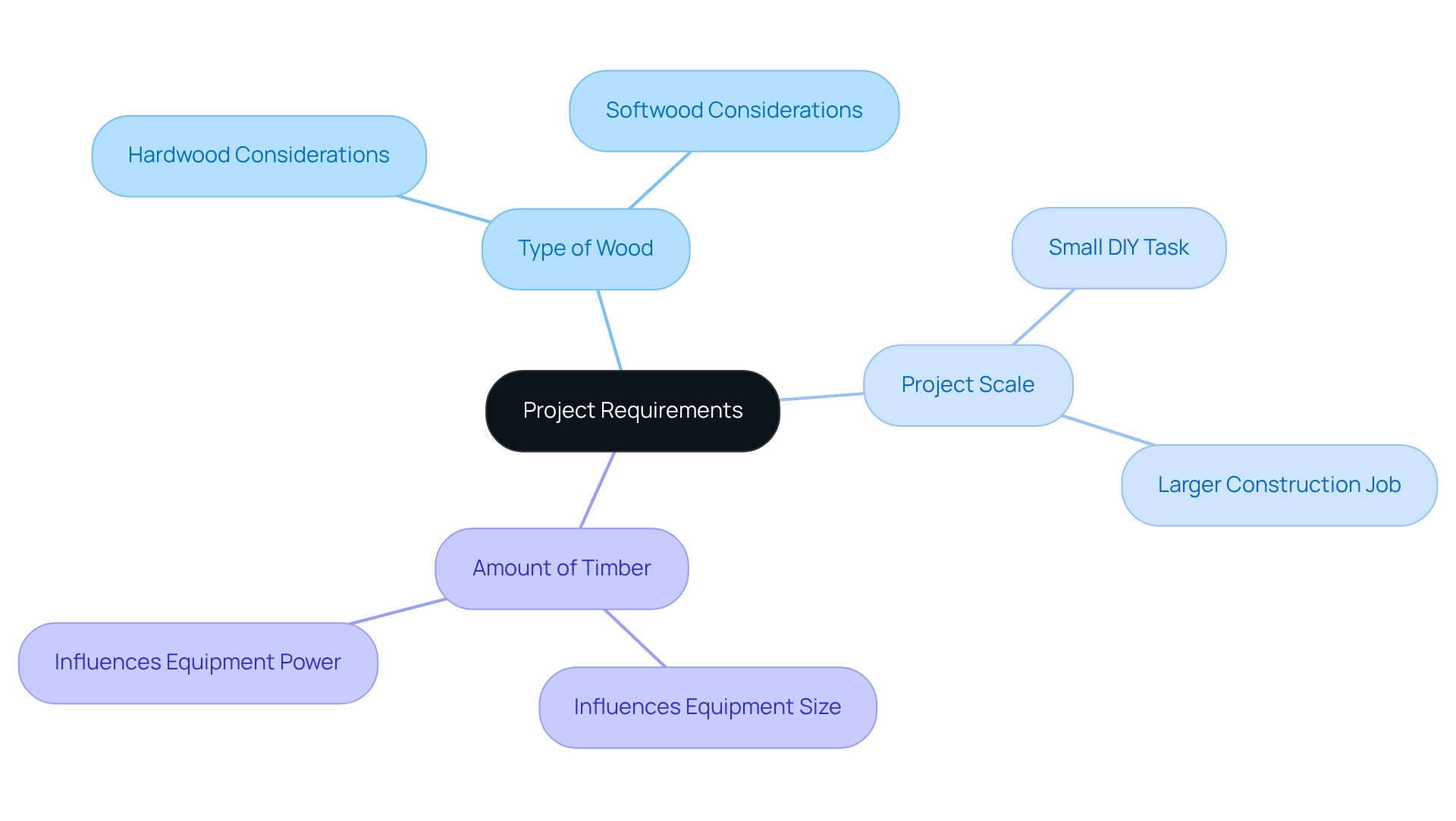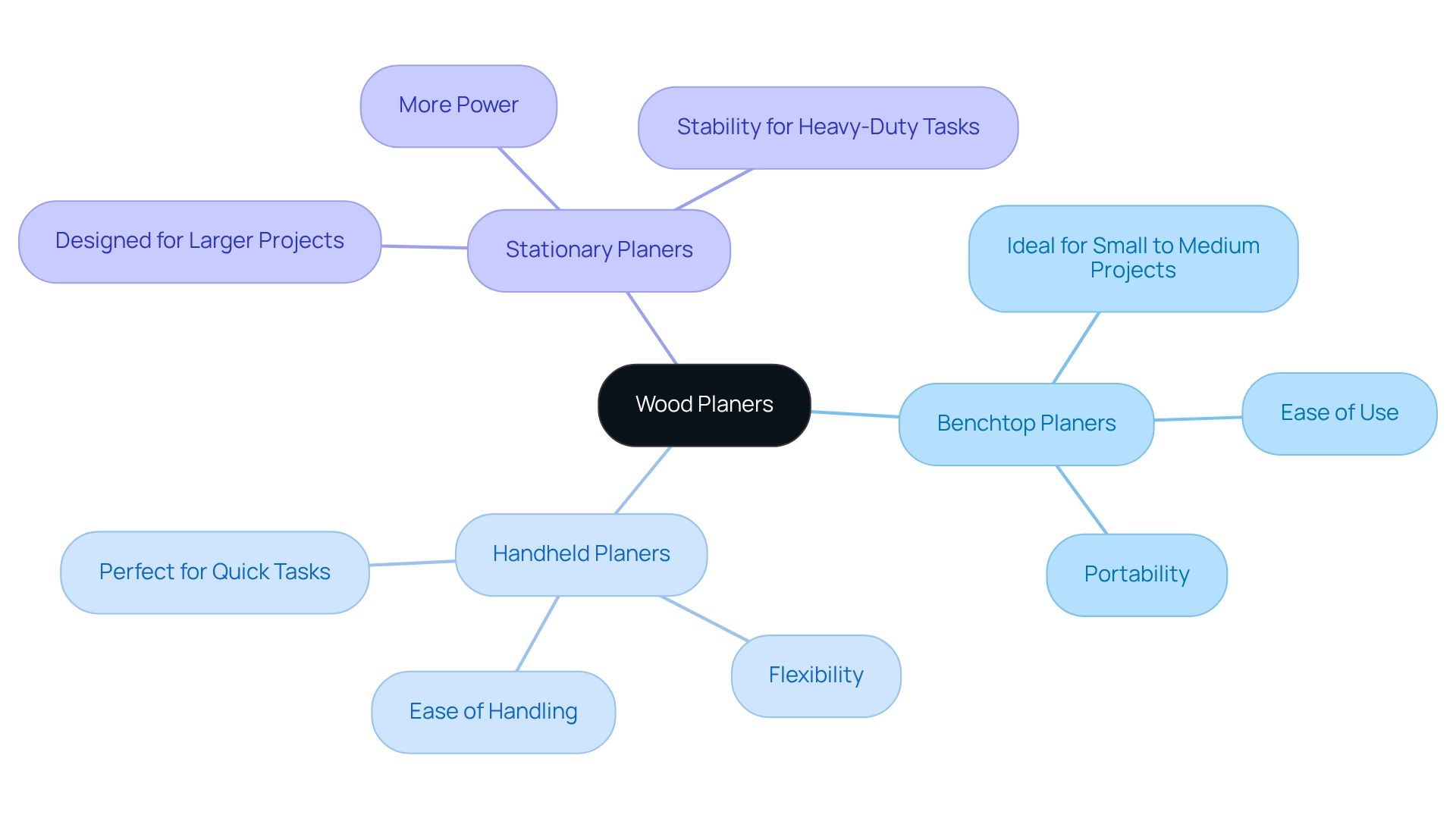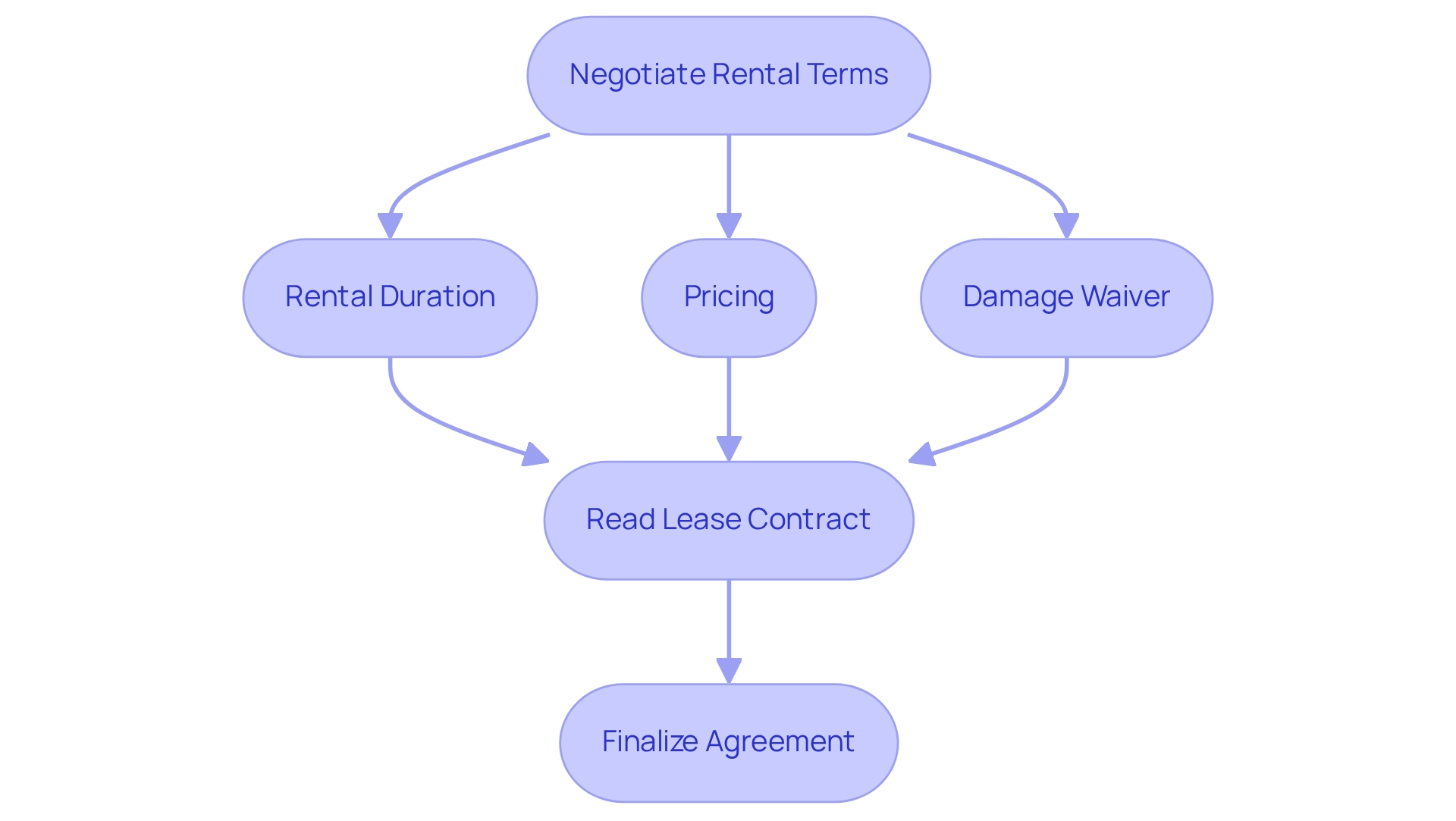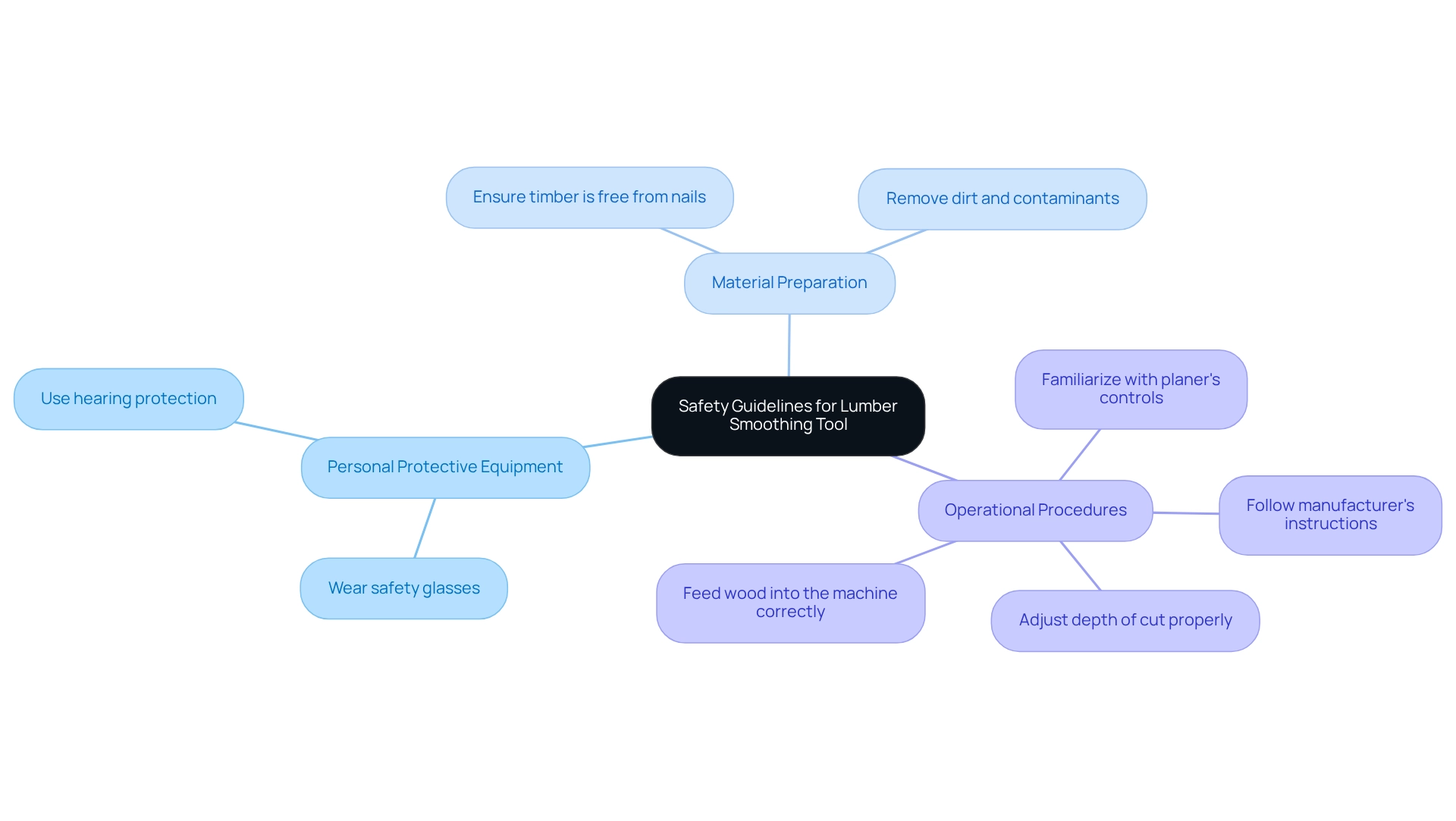Overview
To effectively rent a wood planer for your construction project, begin by assessing your project requirements. This initial assessment is crucial in selecting the appropriate type of planer that meets your needs. Next, conduct thorough research on reputable rental services to ensure you find a reliable provider. Following this, negotiate rental terms that suit your project timeline and budget. Finally, review safety guidelines to guarantee safe operation of the equipment. This article supports this process by providing detailed steps and considerations for each phase, ensuring that you choose the right equipment and operate it safely throughout your project.
Key Highlights:
- Assess project requirements by considering wood type and desired thickness before renting a wood planer.
- Choose the right planer type: benchtop for small projects, handheld for quick tasks, and stationary for larger jobs.
- Research reputable equipment rental services, focusing on quality, terms, and customer support.
- Negotiate rental terms, including duration, pricing, and damage waivers, before finalizing the agreement.
- Review safety guidelines, including the use of personal protective equipment and proper material preparation, to ensure safe operation.
Introduction
Renting a wood planer can elevate a basic woodworking project into a refined masterpiece. However, this process demands meticulous consideration and planning. Understanding project requirements is essential, as it lays the groundwork for selecting the right equipment.
With a range of planers available—from portable benchtop models to robust stationary machines—choosing the right one can profoundly influence the outcome of your work. Furthermore, securing a reputable rental service guarantees access to well-maintained tools along with dependable customer support.
This guide will navigate you through the critical steps, from assessing your needs to finalizing rental agreements, while underscoring safety and operational efficiency for a successful woodworking experience.
Understand Your Project Requirements
Before you rent a wood planer, it is essential to thoroughly evaluate your project needs. Consider the following factors:
- The type of wood you will be working with and the desired thickness after planing.
- The scale of your project—whether it is a small DIY task or a larger construction job.
This comprehension will assist you in choosing the suitable tool and guarantee that it satisfies your particular requirements. For example, if you're dealing with hardwood, you might require a stronger tool compared to softwood.
Furthermore, consider the amount of timber you need to plane, as this will influence the size and power of the equipment you should rent.

Choose the Right Wood Planer for Your Needs
Once you comprehend your project specifications, the next step is to select the appropriate lumber tool. There are several types of wood planers available that cater to varying needs:
- Benchtop Planers: These are ideal for small to medium projects, offering portability and ease of use.
- Handheld Planers: Perfect for quick tasks and smaller pieces of timber, they provide flexibility and ease of handling.
- Stationary Planers: Designed for larger projects, these tools deliver more power and stability for heavy-duty tasks.
Consider factors such as the width of the wood you will be planing and the depth of cut required. For instance, if you need to smooth wide boards, a fixed machine might be essential. Always verify the specifications of the equipment available to rent a wood planer to ensure they fulfill your project requirements. This careful selection will ensure the success of your project.

Find a Reputable Equipment Rental Service
To rent a wood planer, begin by researching reputable equipment rental services in your area. Look for companies with positive reviews and a solid reputation for customer service. EZ Equipment Rental, located in Irving, TX, stands out for its extensive selection of woodworking tools, including jointers and seed planters, and its unwavering commitment to customer satisfaction. With store hours from Monday to Friday, 7:30 AM to 5:30 PM, and Saturday from 7:30 AM to 5:00 PM, EZ Equipment Rental ensures that you have convenient access to their services when you rent a wood planer.
When evaluating leasing services, consider the following essential factors:
- Equipment Quality—ensure that the machines are well-maintained and in good working condition
- Leasing Terms—check the flexibility of leasing conditions, including daily, weekly, or monthly options
- Customer Support—a knowledgeable team can assist you with any questions or issues that arise during your leasing period
Contact EZ Equipment Rental today to inquire about how to rent a wood planer and any additional services they may offer, such as delivery or setup assistance. Experience the reliability and quality that sets EZ Equipment Rental apart in the equipment rental industry.
Negotiate Rental Terms and Finalize Your Agreement
Once you've selected a leasing service and pinpointed the right wood tool, it's time to negotiate the leasing terms. Start by discussing the following critical aspects when you decide to rent a wood planer:
- Rental Duration: Establish how long you will require the planer and inquire about potential discounts for extended rental periods.
- Pricing: Clarify the total cost, ensuring you account for any additional fees related to delivery or insurance.
- Damage Waiver: Evaluate the option of purchasing damage protection coverage to shield yourself against unforeseen accidents.
Before finalizing your agreement, meticulously read the lease contract. Confirm that all terms are clearly defined and that you fully understand your responsibilities regarding equipment care and return conditions. If anything remains unclear, do not hesitate to ask questions.

Review Safety Guidelines and Operational Instructions
Before operating the lumber smoothing tool, which you can rent a wood planer from, it is crucial to examine all safety protocols and usage instructions provided by the rental service. Understanding these guidelines is essential for a safe and efficient woodworking experience. Key safety tips include:
- Personal Protective Equipment (PPE): Always wear safety glasses and hearing protection when operating the planer. This protects you from potential hazards and ensures your well-being.
- Material Preparation: Ensure that the timber is free from nails, dirt, and other contaminants that could harm the machine or cause injury. Proper preparation of materials is vital for both safety and the quality of your work.
- Operational Procedures: Familiarize yourself with the planer's controls and settings. Follow the manufacturer's instructions for adjusting the depth of cut and feeding the wood into the machine. Knowing how to operate the tool effectively maximizes both safety and efficiency, particularly when you rent a wood planer. By adhering to these safety guidelines, you can ensure a safe and efficient woodworking experience, allowing you to focus on your project with confidence.

Conclusion
Understanding the intricacies of renting a wood planer is essential for any woodworking project, whether small or large. By thoroughly assessing project requirements, such as the type of wood and desired thickness, individuals can confidently select the appropriate planer that meets their needs. From benchtop models ideal for smaller tasks to robust stationary planers for larger jobs, the right choice significantly enhances the quality of the finished product.
Equally important is the selection of a reputable rental service. Prioritizing companies known for quality equipment and excellent customer support, such as EZ Equipment Rental, ensures access to well-maintained tools and assistance throughout the rental process. Furthermore, negotiating favorable rental terms and understanding all contractual obligations can help avoid unexpected issues.
Finally, adhering to safety guidelines and operational instructions is paramount for a successful and secure woodworking experience. By combining proper planning, equipment selection, and safety practices, woodworkers can elevate their projects from basic to extraordinary, achieving results that reflect their craftsmanship and dedication. Take action today—choose the right tools and services to transform your woodworking endeavors.
Frequently Asked Questions
What factors should I consider before renting a wood planer?
Before renting a wood planer, consider the type of wood you will be working with, the desired thickness after planing, the scale of your project (small DIY task or larger construction job), and the amount of timber you need to plane.
How does the type of wood affect the choice of wood planer?
The type of wood affects the choice of wood planer because hardwood may require a stronger tool compared to softwood, influencing the power and specifications of the equipment you should rent.
What are the different types of wood planers available for rent?
The different types of wood planers available for rent include: - Benchtop Planers: Ideal for small to medium projects, offering portability and ease of use. - Handheld Planers: Perfect for quick tasks and smaller pieces of timber, providing flexibility and ease of handling. - Stationary Planers: Designed for larger projects, delivering more power and stability for heavy-duty tasks.
What should I verify when selecting a wood planer to rent?
When selecting a wood planer to rent, verify the specifications of the equipment, including the width of the wood you will be planing and the depth of cut required, to ensure they fulfill your project requirements.




